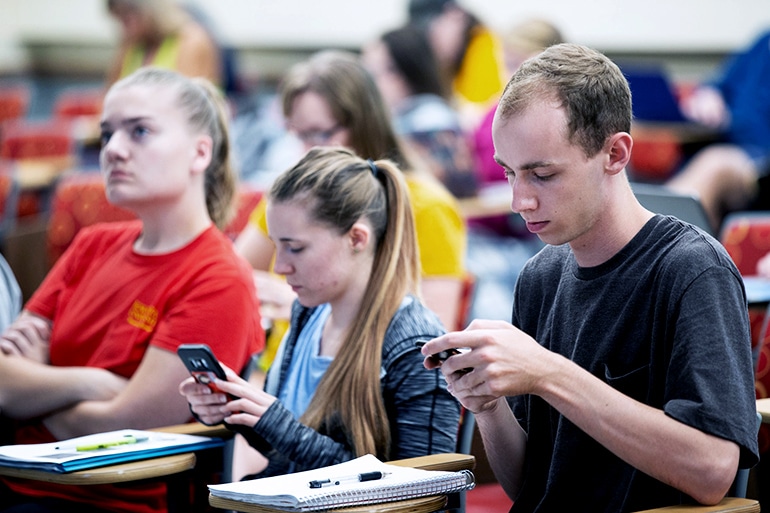Asking questions of students in lecture classes can help them learn new information, but there are limits, according to a new analysis.
Jason Chan, an associate professor of psychology at Iowa State University, makes a point to periodically interrupt his lecture and ask students a question about the material they’ve covered. He does this to regain students’ attention, but more importantly, to enhance their ability to learn new information.
Researchers know the retrieval process is beneficial for new learning. A new meta-analysis by Chan and his colleagues confirms that but found there are limits. The research shows the frequency and difficulty of questions can reverse the effect and be detrimental to learning.
It also is not enough to simply ask a question; Chan says students must respond to see a positive effect on learning.
Asked and answered
“Frequency is a critical factor. There appears to be a trade-off in how often you test students,” Chan says. “If I lecture nonstop throughout class, this lessens their ability to learn the material. However, too many questions, too often, can have a detrimental effect, but we don’t yet know exactly why that happens or how many questions is too many.”
The answer to that question may depend on the length of the lecture and the type or difficulty of the material, Chan says. Given the different dynamics of a class lecture, it may not be possible to develop a universal lecture-to-question ratio. Regardless, Chan says testing students throughout the lecture is a simple step that instructors at any level and in any environment can apply to help students learn.

“This is a cheap, effective method and anyone can implement it in their class,” he says. “You don’t need to give every student an iPad or buy some fancy software—you just need to ask questions and have students answer them in class.”
Researchers examined journal articles from the 1970s to 2016 detailing more than 150 different experiments for their analysis. The researchers looked at what factors influenced the magnitude of this effect, when it happens, and when the effect is reversed.
Why testing works
There are several explanations as to why testing students is beneficial for new learning. The researchers evaluated four main theories for the meta-analysis to examine the strengths and weakness of these explanations from existing research. The data strongly supported what researchers called the integration theory.
“This theory claims that testing enhances future learning by facilitating the association between information on the test and new, especially related, information that is subsequently studied, leading to spontaneous recall of the previously tested information when they learn related information,” says Christian Meissner, a professor of psychology.
“When this testing occurs, people can better tie new information with what they have learned previously, leading them to integrate the old and the new,” Meissner says.
Learning new information requires an encoding process, which is different from the process needed to retrieve that information, the researchers explain. Students must switch between the two when responding to a question. Changing the modes of operation appears to refocus attention and free the brain to do something different.
A majority of the studies in the analysis focused on college students, but some also included older adults, children, and people with traumatic brain injuries. The researchers felt encouraged to find that testing could effectively enhance learning across all these groups.
“Memory retrieval can optimize learning in situations that require people to maintain attention for an extended period of time. It can be used in class lectures as well as employee training sessions or online webinars,” says Sara Davis, a postdoctoral fellow at Skidmore College. “Future research could examine factors that can maximize this potential.”
The research appears in Psychological Bulletin.
Source: Iowa State University



